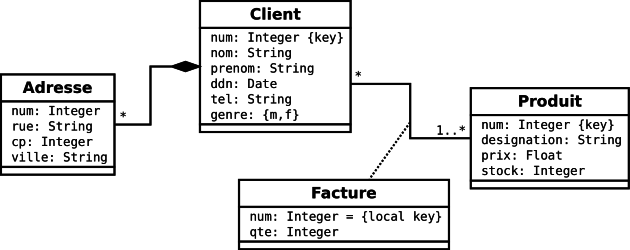MediaTek V
[1 h]

Adresse (#num:integer, #rue:string, #cp:integer, #ville:string, #client => Client)
Type TClient <num:integer, nom:string, prenom:string, ddn:date, tel:string, genre:{'m','f'}>Client de TClient (#num)
Type TProduit <num:integer, designation:string, prix:float, stock:integer>
Produit de TProduit (#num)
Facture (#num:integer, #client =>o Client, #produit =>o Produit, qte:integer)
Question
Réalisez l'implémentation SQL3 sous Oracle.
Solution
Client
CREATE TYPE TClient AS OBJECT (
num NUMBER(4),
nom VARCHAR(20),
prenom VARCHAR(20),
ddn DATE,tel VARCHAR(10),
genre CHAR(1)
);
/
CREATE TABLE Client OF TClient(
PRIMARY KEY (num),
CHECK (genre IN ('m', 'f'))
);
CREATE TABLE Adresse (
num NUMBER(4),
rue VARCHAR(255),
cp NUMBER(5),
ville VARCHAR(255),
client NUMBER(4) REFERENCES Client (num),
PRIMARY KEY (num, rue, cp, ville, client)
);
Produit
CREATE TYPE TProduit AS OBJECT (
num NUMBER(10),
designation VARCHAR(128),
prix NUMBER(5,2),
stock NUMBER(4)
);
/
CREATE TABLE Produit of TProduit (PRIMARY KEY (num));
Facture
CREATE TABLE Facture (
num NUMBER(10),
client REF TClient, produit REF TProduit,qte NUMBER(4),
SCOPE FOR (client) IS Client,
SCOPE FOR (produit) IS Produit
);
Rappel :
Sous Oracle on ne pourra créer de contrainte UNIQUE incluant un OID, donc ici on ne peut pas spécifier la contrainte (#num, #client, #produit).
Alimenter une base RO
Une fois la base créée, insérer des données pour l'alimenter.
On négligera la table Adresse pour la suite de l'exercice (aucun de nos clients n'aura d'adresse).
Question
Initialiser les tables client et produit avec les données de votre choix (au moins deux clients et deux produits).
Indice
Effectuez l'insertion comme en relationnel.
Solution
INSERT INTO Client (num, nom, prenom, ddn, tel, genre)
VALUES (1, 'Colomb', 'Christophe', to_date('01091451', 'DDMMYYYY'), '0812456589' , 'm');
INSERT INTO Client (num, nom, prenom, ddn, tel, genre)
VALUES (2, 'Morin', 'Bernard', to_date('27051931', 'DDMMYYYY'), '0126483621' , 'm');
INSERT INTO Produit (num, designation, prix, stock)
VALUES (1, 'The Matrix', 23.5, 100) ;
INSERT INTO Produit (num, designation, prix, stock)
VALUES (2, 'The Hobbit', 49.3, 100) ;
Question
Initialiser les factures avec les données de votre choix (deux factures de deux lignes chacune au moins).
Indice
Récupérer les OID pour insérer les références aux produits et clients au sein d'une procédure PL/SQL.
Indice
DECLARE oidclient1 REF TClient; ...
BEGINSELECT REF(c) INTO oidclient1
FROM Client c WHERE c.num=...;...
INSERT INTO Facture (num, client, produit, qte)
VALUES (1,oidclient1, ..., 3);
...
END;/
Solution
DECLARE oidclient1 REF TClient; oidproduit1 REF TProduit; oidclient2 REF TClient; oidproduit2 REF TProduit;BEGINSELECT REF(c) INTO oidclient1
FROM Client cWHERE c.num=1;
SELECT REF(c) INTO oidclient2
FROM Client cWHERE c.num=2;
SELECT REF(p) INTO oidproduit1
FROM Produit pWHERE p.num=1;
SELECT REF(p) INTO oidproduit2
FROM Produit pWHERE p.num=2;
INSERT INTO Facture (num, client, produit, qte)
VALUES (1, oidclient1, oidproduit1, 3);
INSERT INTO Facture (num, client, produit, qte)
VALUES (1, oidclient1, oidproduit2, 2);
INSERT INTO Facture (num, client, produit, qte)
VALUES (1, oidclient2, oidproduit2, 6);
INSERT INTO Facture (num, client, produit, qte)
VALUES (1, oidclient2, oidproduit1, 1);
END;/
Questions par navigation d'OID
Vous allez à présent expérimenter la manipulation des OID pour naviguer d'enregistrement en enregistrement, sans utiliser de jointure.
Question
Écrivez une requête permettant d'afficher la liste des factures existantes, avec le nom et le prénom du client.
Indice
NUM CLIENT.NOM CLIENT.PRENOM
--- -------------------- --------------------
1 Colomb Christophe
1 Morin Bernard
Solution
COLUMN num FORMAT A3
SELECT f.num, f.client.nom, f.client.prenom
FROM Facture fGROUP BY f.num, f.client.nom, f.client.prenom;
Question
Écrivez une requête permettant d'afficher le montant total de chaque facture, en rappelant le numéro du client pour chaque facture.
Indice
NUM CLI TOTAL
--- --- -----
1 1 169.1
1 2 319.3
Solution
COLUMN CLI FORMAT A3
SELECT f.num, f.client.num AS cli, SUM(f.qte * f.produit.prix) AS total
FROM Facture fGROUP BY f.num, f.client.num
ORDER BY f.num, f.client.num
Question
Écrivez une requête permettant d'afficher pour chaque client (num et nom) les produits (num et désignation) qu'il a déjà acheté, avec la quantité correspondante.
Indice
CLIENT.NUM CLIENT.NOM PRODUIT.NUM PRODUIT.DESIGNATION QTE
---------- -------------------- ----------- -------------------- ---
1 Colomb 1 The Matrix 3
1 Colomb 2 The Hobbit 2
2 Morin 1 The Matrix 1
2 Morin 2 The Hobbit 6
Solution
COLUMN PRODUIT.NUM FORMAT A11COLUMN PRODUIT.DESIGNATION FORMAT A20SELECT f.client.num, f.client.nom, f.produit.num, f.produit.designation, SUM(f.qte) AS qte
FROM Facture fGROUP BY f.client.num, f.client.nom, f.produit.num, f.produit.designation
ORDER BY f.client.num, f.client.nom, f.produit.num, f.produit.designation